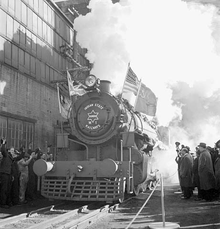Indian locomotive class XD
(Redirected from Indian locomotive class AWD)
| Indian XD | |||||||||||||||||||||||||||||||||||||||||||||||||
|---|---|---|---|---|---|---|---|---|---|---|---|---|---|---|---|---|---|---|---|---|---|---|---|---|---|---|---|---|---|---|---|---|---|---|---|---|---|---|---|---|---|---|---|---|---|---|---|---|---|
 | |||||||||||||||||||||||||||||||||||||||||||||||||
| |||||||||||||||||||||||||||||||||||||||||||||||||
| |||||||||||||||||||||||||||||||||||||||||||||||||
| |||||||||||||||||||||||||||||||||||||||||||||||||
| |||||||||||||||||||||||||||||||||||||||||||||||||
| [1][2][3][4] | |||||||||||||||||||||||||||||||||||||||||||||||||

The Indian locomotive class XD was a class of 2-8-2 "Mikado" type steam locomotives used on 5 ft 6 in (1,676 mm) broad gauge lines in India.[4][5][6]
Variants
AWD: Similar design made by Baldwin Locomotive Works in the World War II period.
CWD: Similar design made by the Canadian Locomotive Company and the Montreal Loco Works. Along with AWD, the largest imported class, numerically.
See also
References
- ^ Hughes 1990, pp. 14, 46.
- ^ Hughes 1996, p. 24.
- ^ Marshall 2009, p. 37.
- ^ a b "Indian Railways 5 ft. 6 in. Gauge 1945 2-8-2 (XE) brochure" (PDF). Vulcan Foundry. Archived from the original (PDF) on 17 October 2013. Retrieved 11 July 2013.
- ^ Hughes 1976, p. 17.
- ^ Marshall 2009, pp. 36, 37, 62–67.
Bibliography
- Hughes, Hugh (1976). Steam in India. Truro, Cornwall: D. Bradford Barton Ltd. ISBN 0851532586.
- Hughes, Hugh (1990). Indian Locomotives: Part 1 – Broad Gauge 1851–1940. Harrow, Middlesex: The Continental Railway Circle. ISBN 0-9503469-8-5. OCLC 21871114.
- Hughes, Hugh (1996). Indian Locomotives: Part 4 – 1941–1990. Harrow, Middlesex: The Continental Railway Circle. ISBN 0-9521655-1-1. OCLC 35135033.
- Marshall, Lawrence G (2009). Indian Broad Gauge Steam Remembered. East Harling, Norfolk: Taverner Publications. ISBN 9781901470154.



